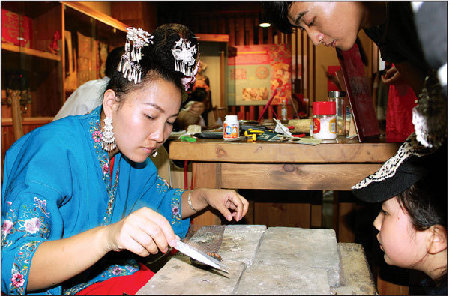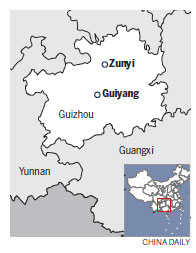
A project launched in Guiyang, the capital of the province, recently aims to bring local cultures closer to city's residents and visitors
Guizhou province is relatively poor in terms of GDP, but extremely rich when it comes to cultural diversity. Out of 56 ethnic groups in China, 54 of them are found in the province.
Recently, a project was launched at the Guizhou Cultural and Creative Park, 1 kilometer from the airport at Guiyang, the capital of the province, to bring local cultures closer to city's residents and visitors.
Called the Weekend Gathering of Intangible Cultural Heritage, organizers invited local performers and inheritors of intangible cultural heritage from the province to showcase their cultures in the park from June to October. A different county will be featured each weekend.
According to Jiang Guiwu, the president of the company that runs the park, 20 counties in total will showcase their cultural heritage in the coming months.
Wearing a traditional outfit and silver jewelry, Tian Feiyan is one of the more than 30 performers from the Miao ethnic group in Taijiang county, some 200 km east of the provincial capital of Guiyang, who presented a dance last weekend.
"We dance when there are festivals," says Tian. "The most recent one is the Sisters Festival ... All the girls go dancing in our village."
The festival is known as the "Miao Valentine's Day", when young girls and boys dance together, eat specially prepared glutinous rice, and make friends. It is celebrated mostly in Taijiang county, and had been listed as national intangible cultural heritage since 2006.
Music is played, drums are banged, and silver accessories jingle as Tian and her friends start to dance.
Besides dancing, the villagers perform a traditional worship ceremony.
Preserved meat, chicken, rice and a jar of Miao liquor are placed on a long table, and people stand around it chanting.
"It (the ceremony) is called Gabaifu. It's folk storytelling through singing and chanting," says 54-year-old Zhang Benyun, "It comprises our history and our prayers for harvest."
Inside the park, there is a museum dedicated to the display of cultural heritage.
Sitting at different stands in the museum hall are local artists and craftsmen. Among them is Wu Shuigen, 50, a Miao silversmith from Shidong town, Taijiang, who is recognized as a national-level intangible cultural heritage inheritor.
"Silver accessories are very important in Miao culture," says Wu. "The designs all mean something in Miao mythology."
Wu started learning the art of making silver jewelry when he was 8, and now his daughter Wu Chunxiu, who has also become a silversmith, teaches tourists how to make silver bracelets and rings in the museum.
"The skill used to be passed on within the family only," says Wu Chunxiu.
"But father wants more people to learn it so that the art isn't lost."
Long Tonghua, 54, from Laotun village in Taijiang does Miao embroidery.
Long started learning traditional embroidery from her mother at seven. Her skill was recognized as province-level intangible cultural heritage in 2015.
With the help of an apprentice, Long gives a introductory lesson about the intricate designs to a group of students visiting the museum.
"This is the first time I am teaching in Mandarin," says Long who typically speaks in Miao with her apprentices.
"I am happy to spread the knowledge of Miao embroidery," she says.
Contact the writers at xingyi@chinadaily.com.cn
 |
|
Wu Chunxiu, a Miao silversmith from Shidong town, Taijiang. Her father Wu Shuigen is recognized as a nationallevel intangible cultural heritage inheritor. Xingyi /China Daily |

(China Daily USA 07/16/2016 page09)